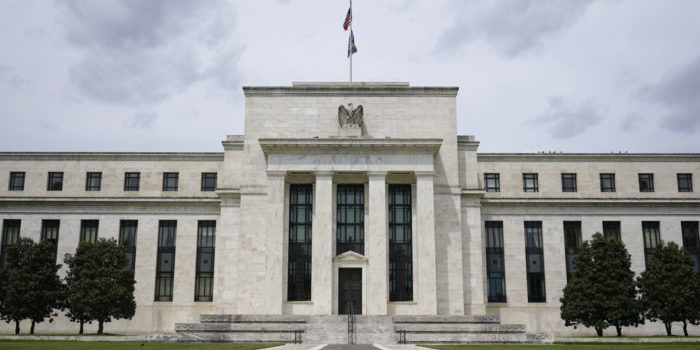(Headline USA) With the end of their two-year fight against inflation in sight, Federal Reserve officials were likely Wednesday to set the stage for the first cut to their key interest rate in four years—a major shift in policy that could eventually lower borrowing costs for U.S. consumers and businesses.
The move may also be a boon for the ascendant Kamala Harris campaign, which has had little difficulty memory-holing the past three years of the Biden administration with a major assist from mainstream media, dark-money billionaires and suppression pollsters.
Harris has quickly shed her status as the least-popular vice president in modern history, and a strategically timed economic jolt could help her clinch the deal in the November election.
After pushing double digits early in Biden’s presidency, inflation—or the rate at which the dollar loses its value—has been creeping closer to the Fed’s 2% target for the past several months.
On Friday, the government said that yearly inflation fell to 2.5% in July, according to the Fed’s preferred inflation measure. That is down from 2.6% the previous month and the lowest since February 2021, when inflation was just starting to accelerate.
A flood of extra oil from Middle Eastern countries—or the last residuals of the national emergency reserves—might also help drive down prices, mitigating the cost-of-living increase that persists even when inflation slows.
Meanwhile, the job market (which was driven largely by the Biden administration’s open-border policies) has cooled, with the unemployment rate rising about a half-point this year to 4.1%. In terms of tackling the inflation problem, that is good news, signaling a likely reduction in spending and cash liquidity.
Fed officials have said that they are seeking to balance the need to keep rates high enough to control inflation without keeping them too high for too long and causing a recession.
Rate cuts—as early as September—could help the Fed achieve a “soft landing,” in which high inflation is defeated without an economic downturn.
“While I don’t believe we have reached our final destination, I do believe we are getting closer to the time when a cut in the policy rate is warranted,” Christopher Waller, a member of the Fed’s governing board, said earlier this month.
Financial market traders have priced in 100% odds that the central bank will reduce its benchmark rate at its Sept. 17-18 meeting, according to futures markets, so Fed Chair Jerome Powell does not need to provide further guidance to markets Wednesday about the timing of a cut, economists say.
Instead, Powell will have more opportunities in the coming months to illustrate how the Fed is thinking about inflation and interest rates, particularly in his speech in late August at the annual Fed conference in Jackson Hole, Wyoming.
As a result, he may not provide much of a hint Wednesday regarding how quickly the Fed will cut rates after it starts doing so. Economists expect relatively gradual cuts, unless there is evidence the job market is faltering, which would spur the Fed to move faster.
Even so, the Fed could alter several parts of the statement it releases after each meeting to lay the groundwork for a cut in September.
In the statement it released after its June meeting, for example, Fed officials said, “In recent months, there has been modest further progress toward the [Fed’s] 2% inflation objective.”
On Wednesday, the Fed could drop “modest” or alter it in some other way to underscore that additional progress on inflation has been achieved.
One encouraging sign for the Fed is that rental prices, a key driver of broader inflation, have started to noticeably cool, as new apartment buildings have been completed in many large cities.
The government’s rental inflation measures have been rising faster than usual, even as rapid apartment building has slowed cost increases for new leases.
Car insurance, which soared more than 20% earlier this year from a year ago, as insurance companies charged more to reflect the pandemic-era spike in new-car prices, have also started to rise more slowly.
Powell has long said the Fed was seeking “greater confidence” that inflation was falling back to the Fed’s 2% target. Earlier this month—even before the latest inflation readings—he said that recent inflation data did “ add somewhat to confidence ” that it is cooling.
Powell and other Fed officials have also worried that strong job growth and rapidly rising paychecks would potentially fuel inflation, as some companies would likely raise prices to offset the higher labor costs.
But hiring and wage growth have slowed in recent months, and Powell this month acknowledged the job market is “not a source of broad inflationary pressures for the economy.”
On Wednesday, the government released a quarterly measure of wage growth, which showed that paychecks are not growing as fast as three months ago, adding to evidence that inflationary pressures have eased.
Adapted from reporting by the Associated Press

